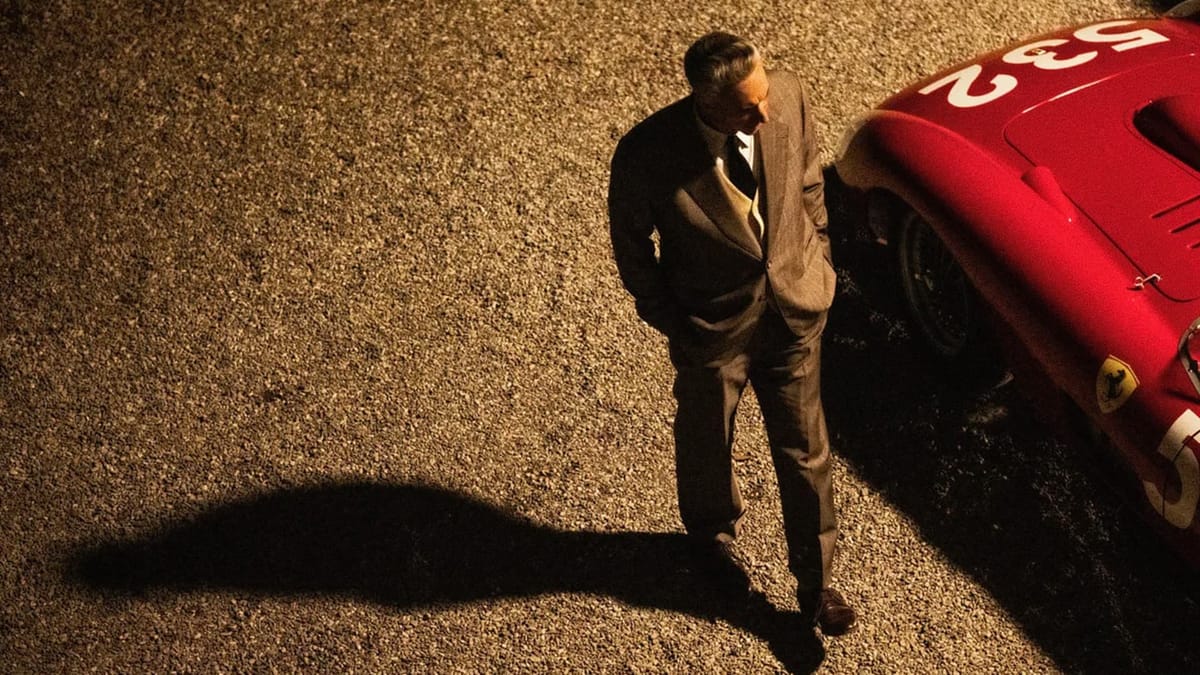Ferrari
Adam Drive putting on an Italian accent. What could go wrong?

I’ve been on a bit of a Michael Mann kick recently. His prevalence in the culture means I’d actually seen four of his films incidentally when I was younger. I finally got around to his classics Heat and Thief in the past two months, and quite enjoyed both. So I was already looking forward to this when I first caught the trailer, and saw Adam Driver in all his glory speaking with an Italian accent, amply filling out David Byrne’s Stop Making Sense suit. It was positioned as a story of serious people making serious cars and walking furiously while scowling even more furiously, and I was in.
Enzo Ferrari (Adam Driver) is in a bind. He and his wife Laura (Penélope Cruz) have built the Ferrari car brand into an international symbol of power and wealth in the decade since its inception in the wake of his racing career. But the expense of these precision-crafted vehicles means not enough are sold to keep the company solvent, and they can’t easily produce more, even if the demand was there. And there’s risk of the demand dropping now that Maserati has toppled their speed record in Ferrari’s home city of Modena, compounded by a tragedy that unfolds when they try to take it back. As if that’s not enough, his marriage is crumbling in the wake of his son’s death, and is further strained by Laura becoming suspicious that he has a second family.
This was an oddly structured movie. Mann’s protagonists tend to be laser focused on what they want, so it was jarring to see Enzo so scattered. He wants to rpeserve the status quo, and only begrudgingly adjusts his focus to saving the business upon learning of their financial woes. As he puts it, “They race in order to sell cars. I sell cars in order to race.” We never get a great sense of what he as a character actually wants, what his ambitions are. He seems propelled by life, making decisions yes, but on a grander scale being directed by some outside force. The death of his son Dino a year or so before haunts him, and does explain turning more towards his mistress Lina (Shailene Woodley) and their son together. But he remains married to the job of designing otherworldly racing machines. All of this swiling while trying to avoid bankruptcy without giving up control of his company.
That being said, the drama is quite compelling. Mann knows how to build tension, and does so admirably here. The competing plot lines which make the film feel unfocused also serve as walls closing in on Enzo. He has to put in just the right amount of work to keep them all humming along happily enough until he can finally rest. You feel the stress bearing down on him, even as he presents a relaxed demeanor to the rest of the world.
All of which is aided by an excellent performance from Driver. I’m not one to judge whether his Italian accent was perfect, but it was good enough that it was neither distracting nor cartoonish. His physical presence was felt at all times, be it through his distinct walk or the way he just took up the space, owning it with his killer suits and sunglasses and sheer size.
But the real heart of the film is Laura. Mann isn’t particularly known for his female characters, so it’s especially notable how much interiority and intensity Penélope Cruz wrings out of her. Contrary to Enzo, there is never a doubt where her mind is. She doesn’t always come out and say it, but her actions speak volumes. While Enzo is happy to be the beloved auto genius, it’s Laura who must bear the burden of what his decisions mean from a business perspective. For each one, she must bear the burden, and understand the dynamics of what it all means. She’s the only one looking out for the business and his best interest, and he pays her little mind. And we see every bit of that on her face, in the intensity of her speech, and her fury towards him. Cruz has mostly been absent from American cinemas since Murder on the Orient Express six years ago, and this film is a great showcase for what we’ve been missing out on.
The narrative present in each individual race that we see (which is only two) is pretty solid, although the uniformity of car styles and colors can make it a bit hard to follow at times. The action, however, is shot impeccably. The racing strategies and lines are clear, the tension as cars muscle for position, moving up and falling back. Mann often shoots from the front bumper, looking at what lies ahead, and even uses a dolly zoom on a straightaway a few times to emphasize the tunnel vision of the driver. There are a handful of bigger moments Mann and cinematographer Erik Messerschmidt do a phenomenal job making you feel in an incredibly visceral way. All of this combines to make us unsure of what the outcome of each race will be. Yes, we know the ultimate resolution of the film will be Ferrari’s survival, as the cars (and its legacy) persist today. But if you don’t know the history (as I don’t), then there is true question as to how it gets there.
It’s just a question of pulling it all together, a task which Mann isn’t quite able to pull off. The movie ends up feeling less than the sum of its parts. Fortunately, its parts are all quite compelling and powerful, so it remains an entertaining film. Yet I find myself only really thinking about a few key moments and indelible images from the movie, rather than the twisty character and power dynamics Mann spends so much time developing.